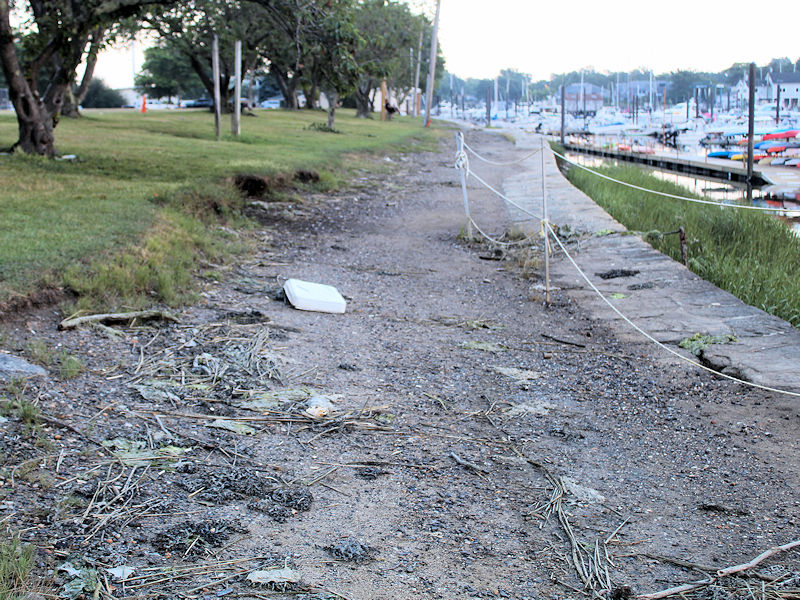PRINT AS PDF
In his, The Water Will Come, Jeff Goodell wrote:
The real x factor here is not the vagaries of climate science, but the complexity of human psychology. At what point will we take dramatic action to cut CO2 pollution? Will we spend billions on adaptive infrastructure to prepare cities for rising waters—or will we do nothing until it is too late?
Outside New York City in the suburban Westchester community, Mamaroneck, one sees evidence of the gradually but unmistakably rising waters. At Harbor Island Park, high tide now regularly overtops the wall built during the Great Depression.
A few decades ago, the waters only ventured into the Park during storms. Now the water’s arrival is a regular occurrence. Instead, one sees the waters cross over Rushmore Avenue onto nearby lawns and into adjacent homes during big storms.
As one walks along the wall, which is crumbling in places, one sees evidence of how the regular incursions of saltwater have eaten away at the grass.
Even as the waters steadily rise in coastal areas, threatening ecosystems and real estate alike, society remains largely on autopilot. Its leaders remain entranced by the siren song of fossil fuel energy, largely oblivious, powerless, or both, to rein it in, roll it back, and phase it out.
Its ability to captivate policymakers and persuade the general public of its indispensability makes the fossil fuel industry an almost perfect planet killer. The greenhouse gases emitted from the burning of fossil fuels are invisible. Their heat-trapping abilities are silent but deadly. Its corporate leaders are above and beyond the law. The industry is free to plunder the world’s climate, decimate its ecosystems, destroy human property, take human life, and shatter human memories and dreams through increased extremes of heat, drought, and precipitation.
Its sociopathic business model is “heads I win, tails you lose.” Society bears the full cost of the industry’s externalities—global subsidies that now amount to $5.9 trillion per year—even as the firms, their leaders, and their captive and corrupted praetorian guard in the world’s capitals are enriched with the industry’s blood money.
On July 3, as the United States prepared to celebrate Independence Day and Ukrainians continued to fight imperialist Russia for their right to live as a free people, the world’s temperature crossed the 17°C (62.6°F) threshold for the first time. By Thursday, July 6, that mark has been surpassed three more times with the Thursday temperature reaching 17.23°C (63.01°F). These dramatic developments garnered international news coverage. However, aside from commentary from the United Nations, no major world leader even entertained the prospect of declaring a climate emergency, much less introduced robust measures to restrict fossil fuel production. Instead, the world continued to go on burning fossil fuels and injecting additional greenhouse gases into the atmosphere.
As a result, more extreme temperatures and weather events lie ahead. Moreover, the sea will continue to rise, reclaiming more and more land, stealing history, and erasing memories.
Goodell describes the fate that lies ahead for many coastal communities. He writes:
[P]eople will notice higher tides that roll in more and more frequently. Water will pool longer in streets and parking lots. Trees will turn brown and die as they suck up salt water. Then a storm will hit, and it will push an astonishing amount of water into the city. Some people will move to new, higher buildings. Others will simply move to higher ground. Roads will be raised. Solar panels will bloom on rooftops. Abandoned houses will linger like ghosts, filling with feral cats and other refugees looking for their own high ground. Water will continue to creep in. It will have a metallic sheen and will smell bad. Kids will get strange rashes and fevers. More people will leave. Seawalls will crumble. In a few decades, low-lying neighborhoods will be knee-deep. Wooden houses will collapse into a sea of soda bottles, laundry detergent jugs, and plastic toothbrushes. Human bones, floated out of caskets, will be a common sight. Treasure hunters will kayak in, using small robotic submersibles to search for coins and jewelry. Modern office buildings and condo towers will lean as the salt water corrodes the concrete foundations and eats at the structural beams. Fish will school in classrooms. Oysters will grow on submerged light poles. Religious leaders will blame sinners for the drowning of the city. Journalists will arrive on floatplanes and write about he return of nature.
But mostly the city will be forgotten, one of many places lost to the attacking sea. In some distant future, someone, or some humanlike machines, may explore the sunken city and find bowling balls, stainless steel knives, gold wedding bands, and ceramic tiles. They may wonder about the people who lived there, what their lives were like, and what they were thinking as their world went under.




